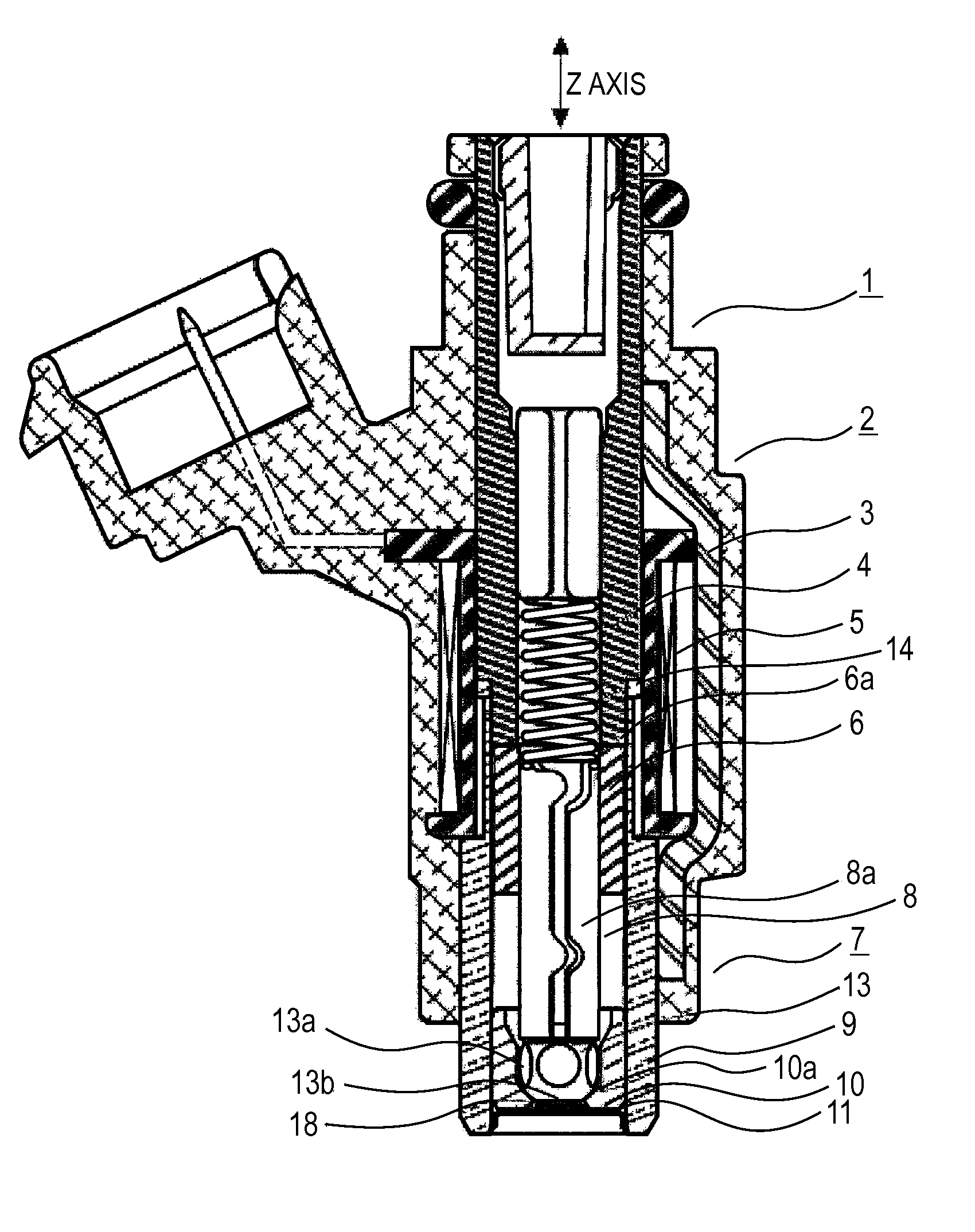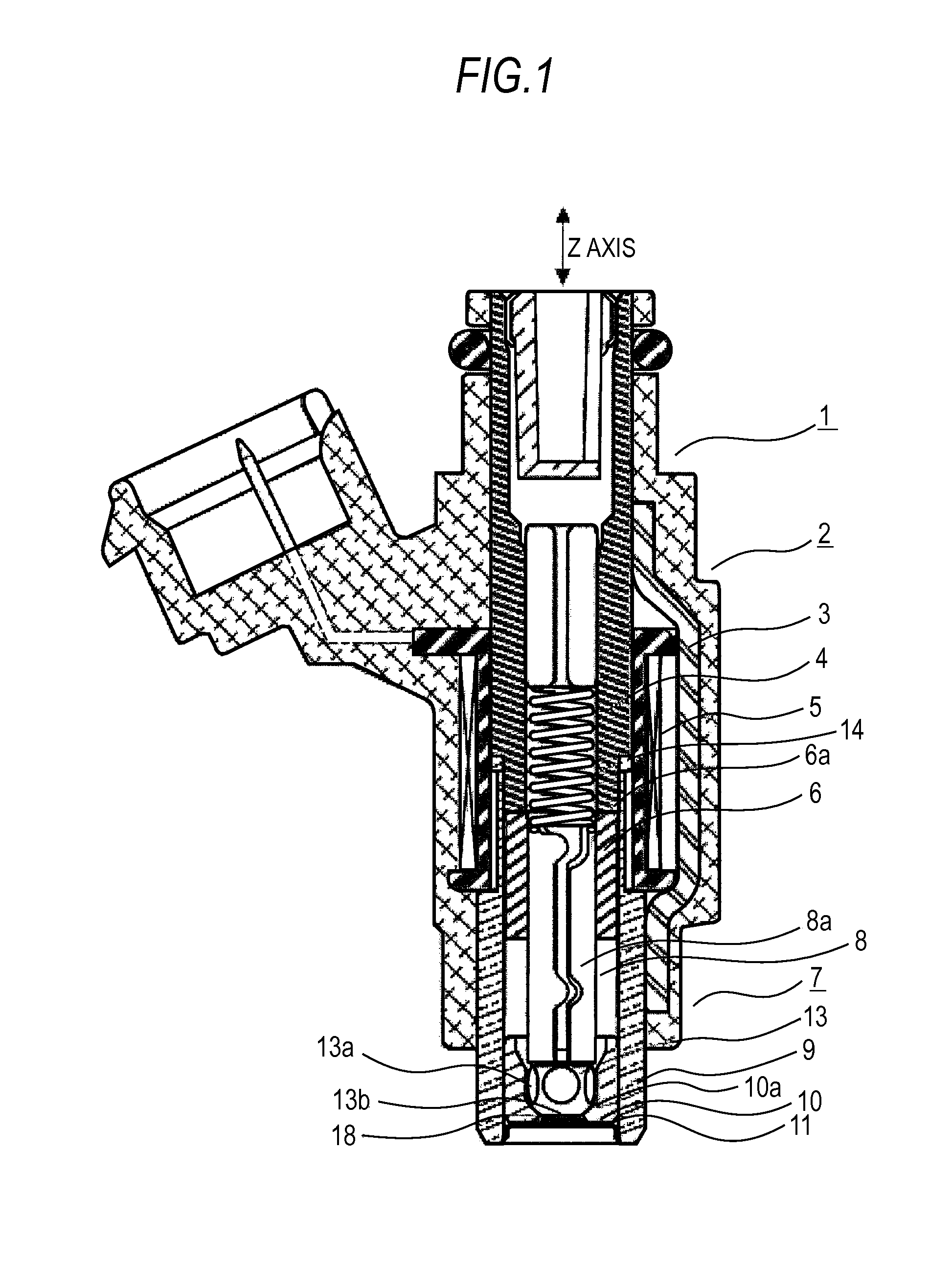Mist forming method using fluid injection valve, fluid injection valve, and mist forming apparatus
a technology of fluid injection valve and forming apparatus, which is applied in the direction of lighting and heating apparatus, machines/engines, and combustion types, etc., can solve the problems of inability to inject fuel, the shape of the intake port and the intake air flow under the influence thereof is not necessarily optimized, and the effect of increasing the degree of design freedom
- Summary
- Abstract
- Description
- Claims
- Application Information
AI Technical Summary
Benefits of technology
Problems solved by technology
Method used
Image
Examples
first embodiment
[0065]A fuel injection valve according to a first embodiment of the invention will be described on the basis of FIG. 1 through FIG. 4. FIG. 1 is an overall cross section showing an entire fuel injection valve 1. FIG. 2 is an enlarged view of a tip end of the fuel injection valve 1 shown in FIG. 1. The fuel injection valve 1 is attached to an intake pipe of an internal combustion engine and supplies pressurized fuel toward the intake pipe from above.
[0066]A lower tip end of the fuel injection valve 1 is engaged on the inside of an intake port of the internal combustion engine and injects fuel downward. A solenoid device 2 generating an electromagnetic force is formed of a housing 3 forming a yoke portion of a magnetic circuit, a core 4 forming a fixed iron core, a coil 5 wound around the core 4, and an armature 6 as a movable iron core.
[0067]A valve device 7 joined to the solenoid device 2 is chiefly formed of a valve seat 10 provided inside a valve main body 9 at the tip end portion...
second embodiment
[0092]A second embodiment of the invention will be described using FIG. 6A.
[0093]The second embodiment is characterized in that, as is shown in the cross section taken on line E-E of FIG. 6A, an aspect ratio (ee1 / ee2) of substantially an oval shape or substantially a crescent shape, which are a sectional shape of a jet immediately below each injection hole 12, is set to a value exceeding 1 (preferably, a value equal to or greater than 1.5). When configured in this manner, an area across which the mists oppose each other is increased so that the Coanda effect exerted due to a pressure distribution acts strongly and the mists come closer or gather closer. Then, after the mists appear substantially as one solid mist, the mists are allowed to catch ambient air chiefly based on the momentum theory and thereby to induce an air flow along a downstream flow direction in a predetermined in-mist portion. An injection amount distribution is maintained so as to peak substantially at the center ...
third embodiment
[0094]A third embodiment of the invention will be described using FIG. 8A through FIG. 8D.
[0095]FIG. 8A is a plan view showing an example of an injection hole location when viewed from upstream in a direction of the center axis of the fuel injection valve 1 of a two-stream spray method. The respective injection holes 12b through 12f correspond to a stream of spray on one side of the two-stream spray and data may be different from one injection hole to another. FIG. 8B shows an example of a jet location and a jet shape immediately below the injection holes located as in the example of the injection hole location of FIG. 8A, and jets 12b1 through 12f1 in every adjacent pair are in close proximity to each other. FIG. 8C shows an example of a mist location and a mist shape in the lower stream of the break length position. It shows a state in which respective mists 12b2 through 12f2 gather so as to encircle the surroundings because the respective mists 12b2 through 12f2 are connected in ...
PUM
 Login to View More
Login to View More Abstract
Description
Claims
Application Information
 Login to View More
Login to View More - R&D
- Intellectual Property
- Life Sciences
- Materials
- Tech Scout
- Unparalleled Data Quality
- Higher Quality Content
- 60% Fewer Hallucinations
Browse by: Latest US Patents, China's latest patents, Technical Efficacy Thesaurus, Application Domain, Technology Topic, Popular Technical Reports.
© 2025 PatSnap. All rights reserved.Legal|Privacy policy|Modern Slavery Act Transparency Statement|Sitemap|About US| Contact US: help@patsnap.com



